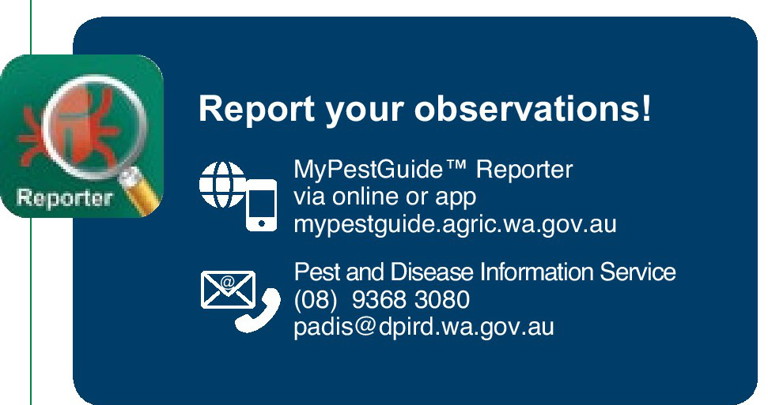Do you know your exotic pome fruit pests?
BY SUSIE MURPHY WHITE PROJECT MANAGER, POMEWEST


EXOTIC PLANT PEST HOTLINE
1800 084 881
Exotic pests can be devastating for the Australian Pome Fruit Industry.
Make sure you and your staff are familiar with plant health symptoms to look for and what these pests look like.
Early detection and reporting of these pests will help protect the Australian Pome Fruit Industry. Report any suspected finding immediately to the Exotic Plant Pest Hotline on 1800 084 881 at Plant Health Australia.
Table 1 is a list of Australian high-priority exotic pests of apples and pears. These pests were identified during the development of the ‘Biosecurity Plan for the Apple and Pear Industry’ in consultation with industry, government and scientists. They have been assessed as high-priority pests based on their potential to enter, establish and spread in Australia due to environmental factors, host range and vectors, as well as the cost to industry of control measures.
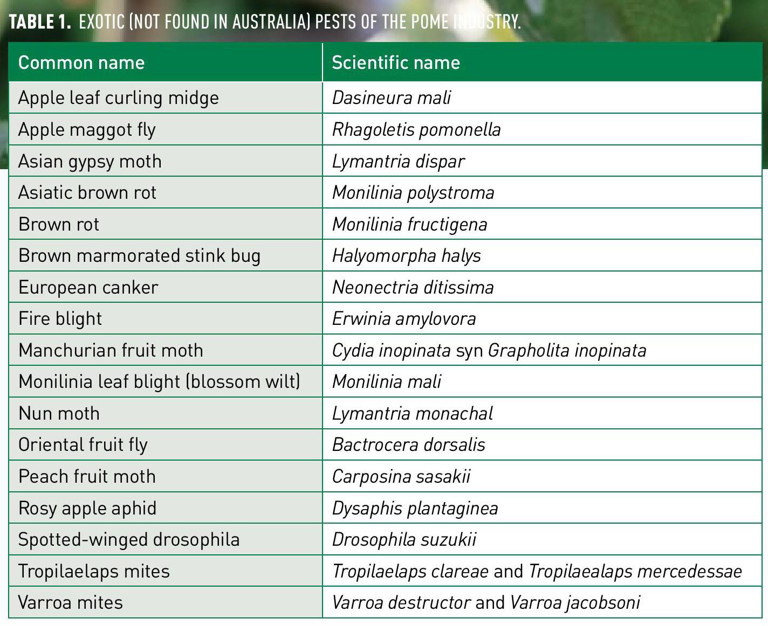
What happens when an exotic pest is found?
Identification of an exotic pest must be confirmed by two separate diagnostic laboratories before any control action is taken.
A temporary quarantine zone, restricting movement of material, may be established while awaiting laboratory results.
Once an exotic pest is confirmed, notification is provided to State and National Governments, as well as affected industries. An official response according to a nationally-approved Response Plan may occur.
Possible restrictions and eradication activities may impact an individual orchard, a growing region, or the entire State. Preparing for these events before they occur is important for business continuity.
Create a biosecurity plan for your business and implement management activities to reduce threats to help protect your business during a pest incursion.
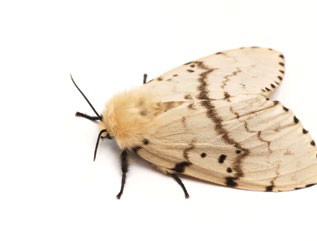
ASIAN gypsy moth has an extremely wide host range, feeding on the foliage of more than 650 species of plants.
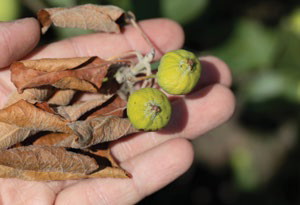
ERWINIA amylovora bacteria attacks fruit trees leaves and causes disease, bacterial burn of apple tree.
Fire blight
Fire blight (Erwinia amylovora) is a serious bacterial disease of pome fruit including apple, pear, quince and loquat. It gets its name from the burnt appearance of affected plants. Symptoms of fire blight infection generally affect all parts of the plants from blossoms and leaves to branches and roots, eventually killing the tree. There is no cure for the infection. The disease spreads easily and rapidly since it can be spread by wind, rain and insects as well as by people, vehicles and equipment.

Asian gypsy moth
Asian gypsy moth (Lymantria dispar) is a destructive pest of forest, horticultural and urban trees and if it were introduced into Australia it could cause extensive environmental and economic damage to our native bush, forests, crops and gardens. The larval (caterpillar) stage of this pest causes heavy defoliation of trees and shrubs — killing them or increasing their susceptibility to other pests. Asian gypsy moth has an extremely wide host range, feeding on the foliage of more than 650 species of plants. Moths have greyish-brown wings (30–40mm wingspan) in males or white with grey markings (40–70mm) in females.
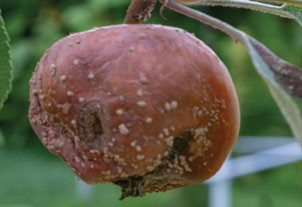
Brown rot
Apple brown rot (Monilinia fructigena) is a fungal pathogen of apple and pear trees. Infected fruit typically develop spreading firm, brown spots that rapidly develop into rotting. These rotting areas will normally be surrounded by conidial pustules, often in concentric circles. These pustules resemble small, raised white-cream spots. Within five days of infection, the entire fruit can be rotted and covered with pustules. Infected fruits become mummified and tend to remain on the tree. Symptoms can spread to the stems resulting in blighted twigs developing into cankers. Leaves may turn dark brown and remain attached instead of abscising. Cankers are generally restricted to the twigs and do not extend into the previous year’s wood. At harvest, apparently healthy fruit may be contaminated with spores and decay during storage and marketing. Apple brown rot produces similar symptoms to other brown rot species that are present in Australia, however, Apple brown rot produces more severe symptoms in apples and pears than other species.
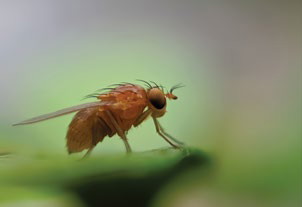
DROSOPHILA suzukii, commonly called the spotted wing drosophila or SWD, is a fruit fly originally from southeast Asia.
Spotted winged drosophila
Spotted winged drosophila (SWD, Drosophila suzukii) attacks a range of soft-skinned fruit species, depositing eggs in maturing firm fruit. Adult SWD are yellowbrown coloured flies with dark bands on the abdomen and red eyes. They are 23mm in length and the female flies have a serrated ovipositor at the tip of their abdomen. This ovipositor allows the females to lay eggs in healthy, thin-skinned fruit. Males have a small dark spot on the front edge near the tip of each forewing (unlike females). Larvae are cream or white coloured and about 3mm long. Pupae are red to brown, 2–3mm in length and cylinder shaped with two small projections on the end.
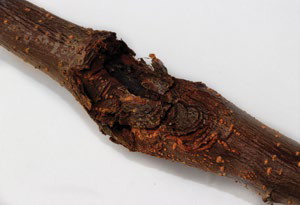
European canker
European canker (Neonectria galligena), also known as crotch canker or eye rot, is an economically important fungal disease of apples and pears throughout the world causing fruit losses of up to 60 per cent. The fungus has a wide host range, with the main hosts including apple, pear, maple and birch trees. European canker symptoms are mostly present on branches and trunks of trees. Early signs of infection are reddish brown lesions which develop on small branches, generally around a leaf scar, spur or pruning wound. Symptoms usually present in late spring or early summer.
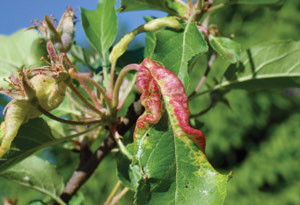
Rosy apple aphid
The Rosy apple aphid (RAA, Dysaphis plantaginea) is considered the most destructive aphid species that attacks apples, with infestation resulting in major damage to leaves, roots and fruit. RAAs are small, softbodied insects with piercing sucking mouthparts and two cornicles, which resemble tailpipes, projecting from the back of the abdomen. Adults grow up to 2.5mm in length and can be winged or wingless. Winged adults are a brownish-green to black colour, while wingless adults are rosy brown or purple and covered in a greyish-white wax coating.
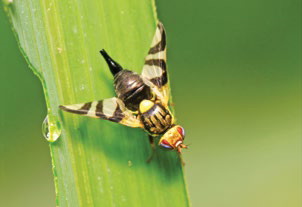
Apple maggot
The apple maggot (Rhagoletis pomonella) is one of the most serious fruit fly pests of North America, mainly damaging apples but also attacking a range of stone fruit. Direct host fruit damage occurs through feeding activities of the larvae and secondary infections can occur through egg laying wounds. Adult flies are smaller than house flies (up to 5mm in length with a wingspan of just over 10mm) with black bodies, yellowish head and legs and greenish eyes. Wings are clear with characteristic black bands and a white spot can be seen on the thorax. The abdomen is black with three (males) or four (females) light coloured cross bands. The larvae can grow up to 10mm in length and are usually cream coloured. The larvae are normally contained within the fruit tissue of hosts. Pupae are yellow/brown, about 5mm long and oval shaped.
Found a pest or disease?
If you find any suspicious pests or diseases, or something you are unsure about, report it immediately to the Pest and Disease Information Service either by phone or through the My Pest Guide Reporter app on your phone. This is a free service and you will receive a timely response with identification information and management options.
MORE INFORMATION
Exotic Plant Pest Hotline on 1800 084 881 at Plant Health Australia.
Pest and Disease Information Service at the Department of Primary Industries and Regional Development on (08) 9368 3080 or by email: padis@dpird.wa.gov.au
Contact Susie Murphy White at susan.murphy-white@dpird.wa.gov.au or phone (08) 9777 0151.
